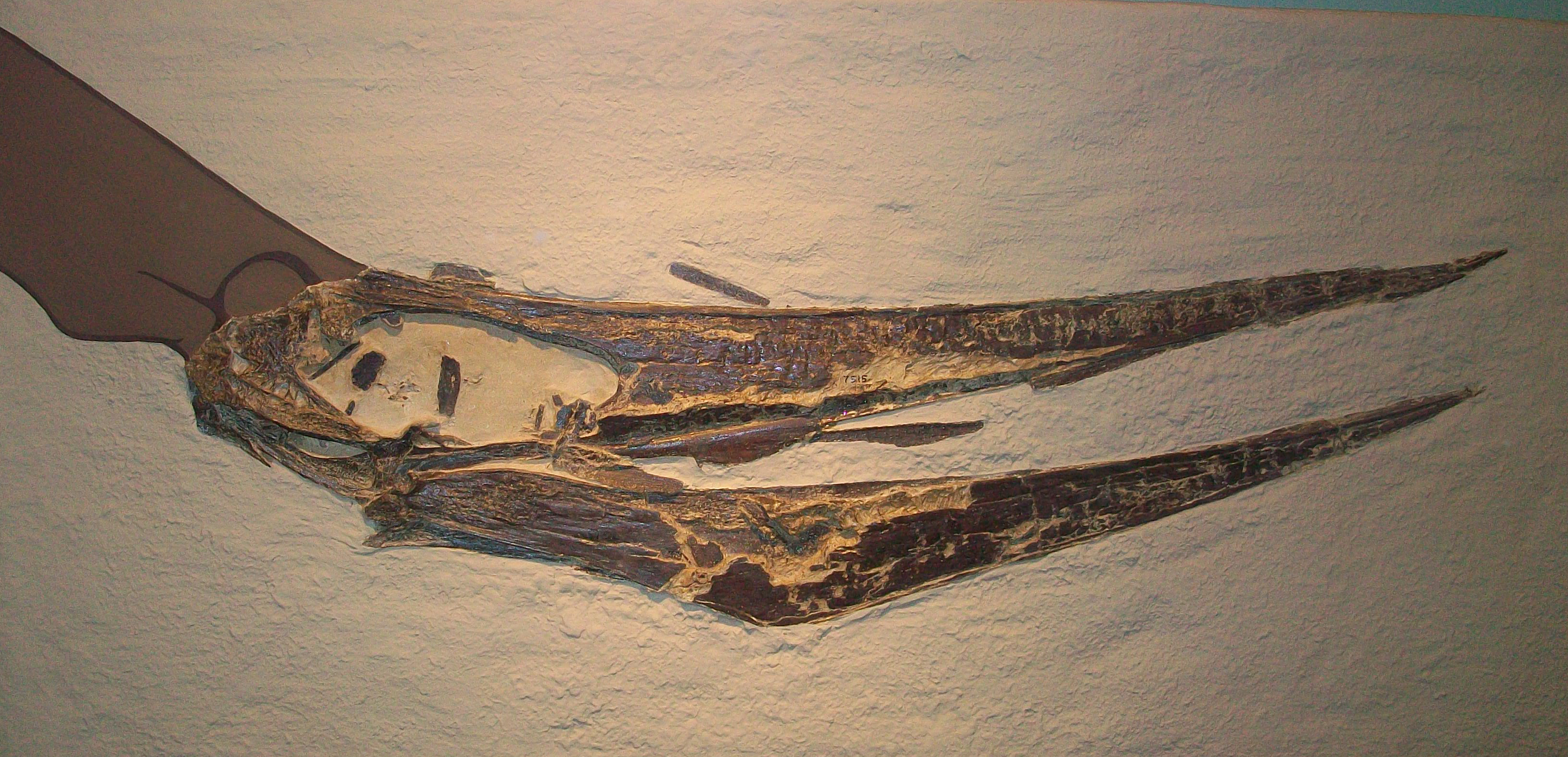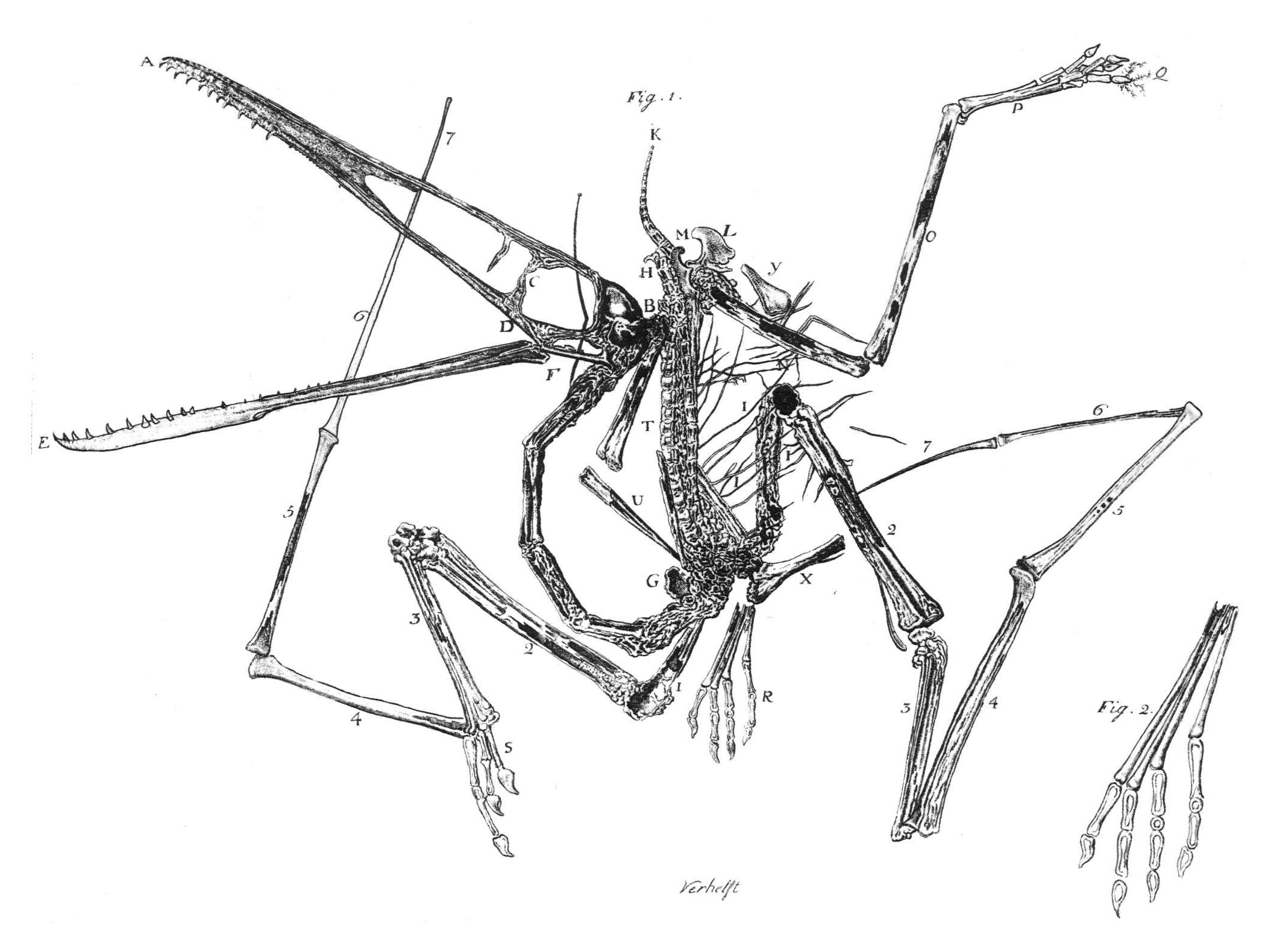|
Longchengpterus
''Longchengpterus'', sometimes misspelled as "Lonchengopterus", is a genus of istiodactylid pterodactyloid pterosaur from the Barremian-Aptian-age Lower Cretaceous Jiufotang Formation of Chaoyang, Liaoning, China. Its fossil remains dated back about 120 million years ago. Etymology The genus was named in 2006 by Wang Li, Li Li, Duan Ye and Cheng Shao-li. The genus name is derived from the old name of Chaoyang City, ''Longcheng'', and a Latinized Greek ''pteron'', "wing". The specific name honors Zhao Dayu, the president of Shenyang Normal University and a contributor to the founding of the Western Liaoning Institute of Mesozoic Paleontology. Description ''Longchengpterus'' is based on holotype LPM 00023, found at Yuanjiawa near Dapingfanga, a compressed incomplete skeleton and partial skull on a single plate. The posterior part of the skull has been damaged. It is elongated with a length of . The large skull opening, the ''fenestra nasantorbitalis'', is triangular in fo ... [...More Info...] [...Related Items...] OR: [Wikipedia] [Google] [Baidu] |
Istiodactylidae
Istiodactylidae is a small family of pterosaurs. This family was named in 2001 after the type genus ''Istiodactylus'' was discovered not to be a member of the genus '' Ornithodesmus''. Systematics and distribution Remains of taxa that can be confidently assigned to Istiodactylidae have been found in the UK and China, in rocks dating from the Early Cretaceous period (Barremian to Aptian stage). Arbour and Currie (2011) described Canadian ''Gwawinapterus beardi'' as a member of Istiodactylidae living in the late Cretaceous (upper Campanian stage); however, Witton (2012) suggested the tooth replacement pattern in this animal does not match that of pterosaurs, suggesting that the species might be non-pterosaurian. Additional research suggested that the species was in fact a fish. The earliest known species might be '' Archaeoistiodactylus linglongtaensis'', from the Middle Jurassic of China; however, it also has been suggested that the holotype specimen of this species might actuall ... [...More Info...] [...Related Items...] OR: [Wikipedia] [Google] [Baidu] |
Pteranodon Longiceps
''Pteranodon'' (); from Ancient Greek (''pteron'', "wing") and (''anodon'', "toothless") is a genus of pterosaur that included some of the largest known flying reptiles, with ''P. longiceps'' having a wingspan of . They lived during the late Cretaceous geological period of North America in present-day Kansas, Nebraska, Wyoming, South Dakota and Alabama. More fossil specimens of ''Pteranodon'' have been found than any other pterosaur, with about 1,200 specimens known to science, many of them well preserved with nearly complete skulls and articulated skeletons. It was an important part of the animal community in the Western Interior Seaway. ''Pteranodon'' was not a dinosaur. By definition, all dinosaurs belong to the group Dinosauria; ''Pteranodon'' belongs to the group Pterosauria. Nonetheless, ''Pteranodon'' is the most famous pterosaur, frequently featured in dinosaur media and strongly associated with dinosaurs by the general public. While not dinosaurs, pterosaurs such as ... [...More Info...] [...Related Items...] OR: [Wikipedia] [Google] [Baidu] |
Istiodactylus
''Istiodactylus'' is a genus of pterosaur that lived during the Early Cretaceous period, about 120 million years ago. The first fossil was discovered on the English Isle of Wight in 1887, and in 1901 became the holotype specimen of a new species, ''O. latidens'' (Latin for "wide tooth"), in the genus ''Ornithodesmus''. This species was moved to its own genus, ''Istiodactylus'', in 2001; this name is Greek for "sail finger". More specimens were described in 1913, and ''Istiodactylus'' was the only pterosaur known from three-dimensionally preserved fossils for much of the 20th century. In 2006, a species from China, ''I. sinensis'', was assigned to ''Istiodactylus'', but it has also been suggested to belong to a different genus. ''Istiodactylus'' was a large pterosaur; estimates of its wingspan range from . Its skull was about long, and was relatively short and broad for a pterosaur. The front of the snout was low and blunt, and bore a semicircle of 48 teeth. The triangular teeth ... [...More Info...] [...Related Items...] OR: [Wikipedia] [Google] [Baidu] |
Chaoyang City
Chaoyang () is a prefecture-level city in western Liaoning province, People's Republic of China. With a vast land area of almost , it is by area the largest prefecture-level city in Liaoning, and borders on Hebei province and the Inner Mongolia Autonomous Region to the west. The area under Chaoyang's jurisdictional control is split up into two counties (Jianping, Chaoyang), two urban districts (Longcheng, Shuangta), two county-level cities (Beipiao, Lingyuan), and the Harqin Left Wing Mongolian Autonomous County. The total regional population is 3 million, while the urban centre where the government office is located has a population of 430,000 and forms the core of Chaoyang. Known as China's 'fossil city', many important paleontological discoveries have been made in Chaoyang, and the Harqin region is the oldest currently known prehistoric site in northern China. Two of the most remarkable Early Cretaceous birds known to date were recovered in the vicinity of the Jiufotang Form ... [...More Info...] [...Related Items...] OR: [Wikipedia] [Google] [Baidu] |
Pterodactylus Antiquus
''Pterodactylus'' (from Greek () meaning 'winged finger') is an extinct genus of pterosaurs. It is thought to contain only a single species, ''Pterodactylus antiquus'', which was the first pterosaur to be named and identified as a flying reptile. Fossil remains of ''Pterodactylus'' have primarily been found in the Solnhofen limestone of Bavaria, Germany, which dates from the Late Jurassic period (early Tithonian stage), about 150.8 to 148.5 million years ago. More fragmentary remains of ''Pterodactylus'' have tentatively been identified from elsewhere in Europe and in Africa. ''Pterodactylus'' was a generalist carnivore that probably fed on a variety of invertebrates and vertebrates. Like all pterosaurs, ''Pterodactylus'' had wings formed by a skin and muscle membrane stretching from its elongated fourth finger to its hind limbs. It was supported internally by collagen fibres and externally by keratinous ridges. ''Pterodactylus'' was a small pterosaur compared to other fam ... [...More Info...] [...Related Items...] OR: [Wikipedia] [Google] [Baidu] |
Outgroup (cladistics)
In cladistics or phylogenetics, an outgroup is a more distantly related group of organisms that serves as a reference group when determining the evolutionary relationships of the ingroup, the set of organisms under study, and is distinct from sociological outgroups. The outgroup is used as a point of comparison for the ingroup and specifically allows for the phylogeny to be rooted. Because the polarity (direction) of character change can be determined only on a rooted phylogeny, the choice of outgroup is essential for understanding the evolution of traits along a phylogeny. History Although the concept of outgroups has been in use from the earliest days of cladistics, the term "outgroup" is thought to have been coined in the early 1970s at the American Museum of Natural History. Prior to the advent of the term, various other terms were used by evolutionary biologists, including "exgroup", "related group", and "outside groups". Choice of outgroup The chosen outgroup is hypothe ... [...More Info...] [...Related Items...] OR: [Wikipedia] [Google] [Baidu] |
Taxa
In biology, a taxon ( back-formation from '' taxonomy''; plural taxa) is a group of one or more populations of an organism or organisms seen by taxonomists to form a unit. Although neither is required, a taxon is usually known by a particular name and given a particular ranking, especially if and when it is accepted or becomes established. It is very common, however, for taxonomists to remain at odds over what belongs to a taxon and the criteria used for inclusion. If a taxon is given a formal scientific name, its use is then governed by one of the nomenclature codes specifying which scientific name is correct for a particular grouping. Initial attempts at classifying and ordering organisms (plants and animals) were set forth in Carl Linnaeus's system in ''Systema Naturae'', 10th edition (1758), as well as an unpublished work by Bernard and Antoine Laurent de Jussieu. The idea of a unit-based system of biological classification was first made widely available in 1805 in the ... [...More Info...] [...Related Items...] OR: [Wikipedia] [Google] [Baidu] |
Cladogram
A cladogram (from Greek ''clados'' "branch" and ''gramma'' "character") is a diagram used in cladistics to show relations among organisms. A cladogram is not, however, an evolutionary tree because it does not show how ancestors are related to descendants, nor does it show how much they have changed, so many differing evolutionary trees can be consistent with the same cladogram. A cladogram uses lines that branch off in different directions ending at a clade, a group of organisms with a last common ancestor. There are many shapes of cladograms but they all have lines that branch off from other lines. The lines can be traced back to where they branch off. These branching off points represent a hypothetical ancestor (not an actual entity) which can be inferred to exhibit the traits shared among the terminal taxa above it. This hypothetical ancestor might then provide clues about the order of evolution of various features, adaptation, and other evolutionary narratives about an ... [...More Info...] [...Related Items...] OR: [Wikipedia] [Google] [Baidu] |
Symphysis
A symphysis (, pl. symphyses) is a fibrocartilaginous fusion between two bones. It is a type of cartilaginous joint, specifically a secondary cartilaginous joint. # A symphysis is an amphiarthrosis, a slightly movable joint. # A growing together of parts or structures. Unlike synchondroses, symphyses are permanent. Examples The more prominent symphyses are: * the pubic symphysis * sacrococcygeal symphysis * intervertebral disc between two vertebrae * in the sternum, between the manubrium and body * mandibular symphysis In human anatomy, the facial skeleton of the skull The skull is a bone protective cavity for the brain. The skull is composed of four types of bone i.e., cranial bones, facial bones, ear ossicles and hyoid bone. However two parts are more p ..., in the jaw Symphysis disorders Pubic symphysis diastasis Pubic symphysis diastasis, is an extremely rare complication that occurs in women who are giving birth. Separation of the two pubic bones during deliv ... [...More Info...] [...Related Items...] OR: [Wikipedia] [Google] [Baidu] |
Holotype
A holotype is a single physical example (or illustration) of an organism, known to have been used when the species (or lower-ranked taxon) was formally described. It is either the single such physical example (or illustration) or one of several examples, but explicitly designated as the holotype. Under the International Code of Zoological Nomenclature (ICZN), a holotype is one of several kinds of name-bearing types. In the International Code of Nomenclature for algae, fungi, and plants (ICN) and ICZN, the definitions of types are similar in intent but not identical in terminology or underlying concept. For example, the holotype for the butterfly '' Plebejus idas longinus'' is a preserved specimen of that subspecies, held by the Museum of Comparative Zoology at Harvard University. In botany, an isotype is a duplicate of the holotype, where holotype and isotypes are often pieces from the same individual plant or samples from the same gathering. A holotype is not necessaril ... [...More Info...] [...Related Items...] OR: [Wikipedia] [Google] [Baidu] |





